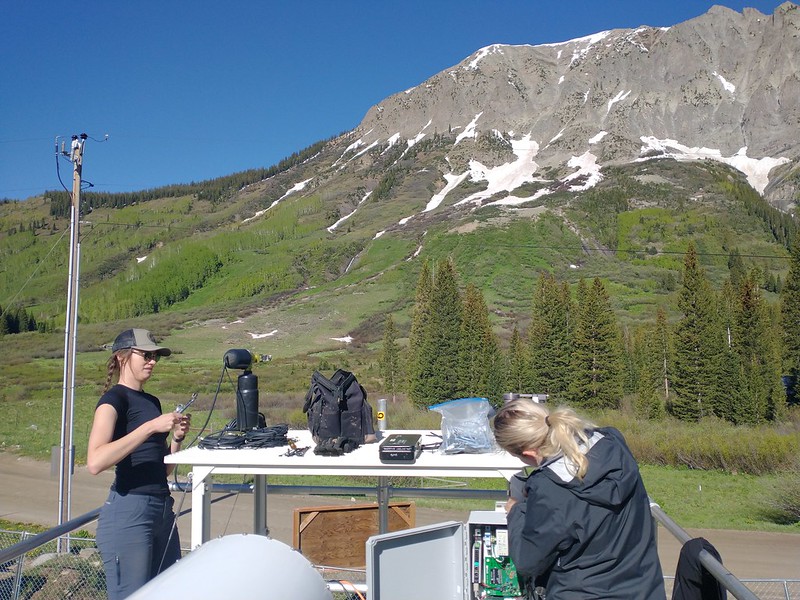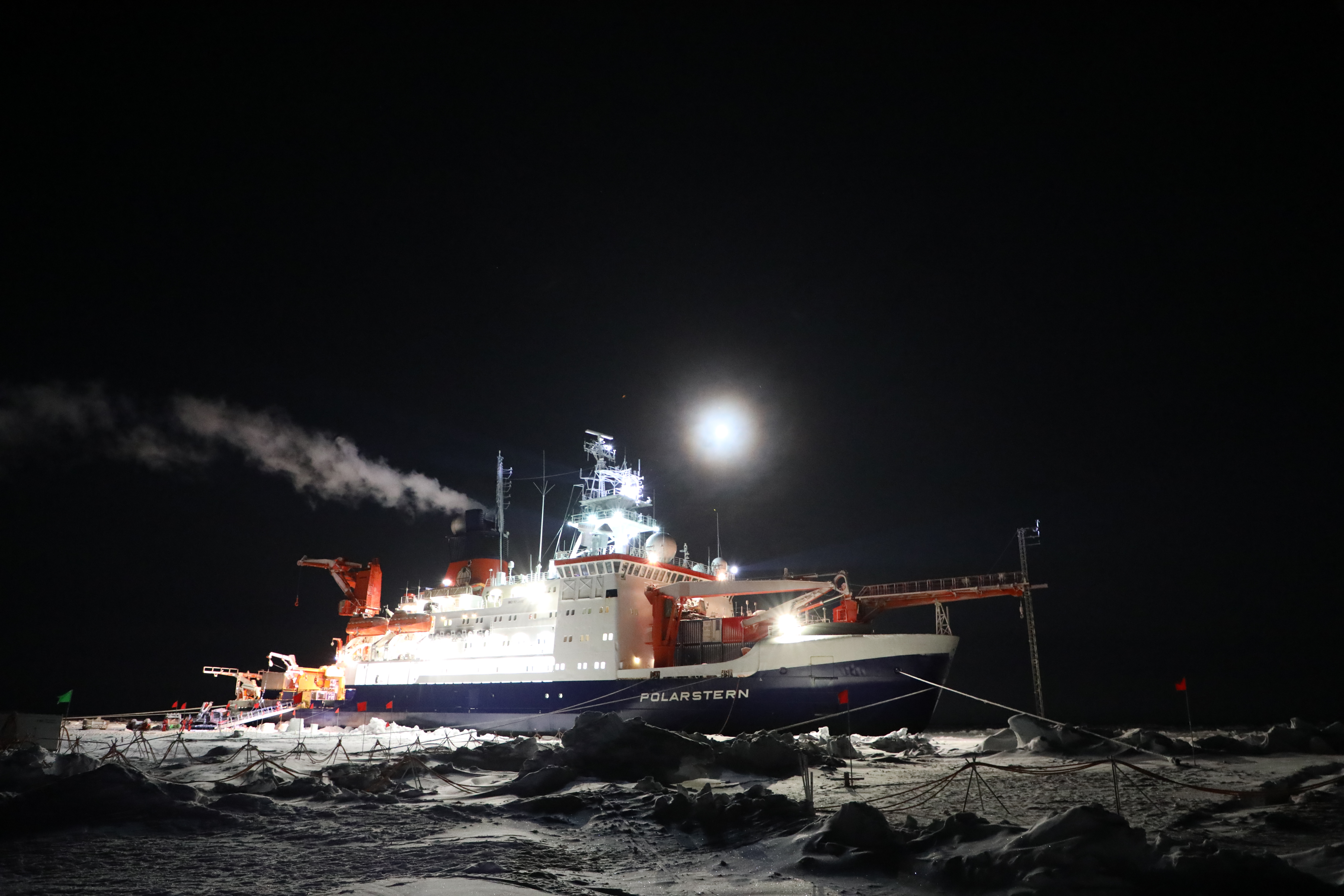An ARM View of AGU23
Published: 18 January 2024
In the maelstrom of a 5-day international conference, DOE and ARM find ways to shine

If “Seinfeld” is a show about nothing, the annual fall conference of the American Geophysical Union (AGU) is a show about everything.
Packed with about 25,000 attendees, the 2023 AGU Fall Meeting (AGU23) in San Francisco, California, enabled thousands of encounters at town halls, plenaries, oral presentations, poster sessions, and ad hoc parties. The meeting drew a virtual audience as well.
From December 11 to 15, scientists from more than 100 countries shared research on subjects ranging from space weather and Martian dunes to prairie potholes and emissions from car tires.
Such a diversity of subjects is in accord with AGU23’s theme of “Wide.Open.Science,” a nod to 2023 as the Year of Open Science declared by 17 federal agencies. The idea is to make data and discoveries accessible, sharable, interoperable, and (consequently) impactful.
The U.S. Department of Energy (DOE), one of the agencies that participated in the Year of Open Science, showcased its own diversity of research during AGU23. For one, data from DOE’s Atmospheric Radiation Measurement (ARM) user facility informed more than 130 presentations.
Many of the ARM presentations involved work funded by DOE’s Atmospheric System Research (ASR) program.
ARM’s booth at AGU23 attracted about 350 visitors. They included DOE Undersecretary for Science and Innovation Geraldine “Geri” Richmond, who gave a featured plenary talk at the meeting.
Key ARM Campaigns Represented at AGU23

Presentations using data from ARM’s three fixed-location observatories and three mobile facilities illustrated a diversity of global climate regimes.
Talks and posters on several recent ARM field campaigns showcased what the user facility focuses on: clouds, radiation, aerosols, and precipitation.
From October 2021 through September 2022, the TRacking Aerosol Convection interactions ExpeRiment (TRACER) took place around Houston, Texas. It is a region where marine, rural, and urban influences combine to affect convective activity. TRACER data, now under the lens of modelers and other scientists, will help simulate conditions in similarly stormy, urbanized coastal regions around the world.
The Surface Atmosphere Integrated Field Laboratory (SAIL) campaign had a big presence as well. From September 2021 to June 2023 near Crested Butte, Colorado, researchers collected bedrock-to-atmosphere measurements in complex mountainous terrain.
Ending in February 2024 is the yearlong Eastern Pacific Cloud Aerosol Precipitation Experiment (EPCAPE) in La Jolla, California. This campaign is collecting unprecedented four-season data on the properties of coastal marine clouds, including their radiative effects and the role human-made particles play. EPCAPE data will help inform and validate the numerical models used to represent ocean-cloud processes.
Also of note were presentations looking back at the Multidisciplinary Drifting Observatory for the Study of Arctic Climate (MOSAiC), an epically comprehensive 2019–2020 expedition involving 20 nations. ARM deployed more than 50-plus instruments for this international study of the atmosphere, ice, ocean, and ecosystem in the central Arctic.
TRACER Traces

On December 11, there were TRACER-related presentations on uncrewed systems for aerial research, biogenic volatile organic compounds (BVOCs) across Houston, and the chemistry of secondary organic aerosols created when BVOCs oxidize.
In the latter invited talk, Lindsay Yee of the University of California Berkeley outlined a case study of using mass spectrometry to better identify the chemical composition of unknown biogenic secondary organic aerosols captured in air samples. Normally, she said, 80% of the field-observed spectra of such aerosols remain unidentified.
That same day, an invited presentation by University of Oklahoma PhD student Francesca Lappin explained research on the influence of sea breezes on the atmospheric boundary layer over the Houston region.
The main set of TRACER-related oral presentations on December 14 included insights into boundary-layer evolution in an urban coastal environment, human influences on thunderstorms, and convective cell characteristics.
TRACER research highlights were also the stuff of poster sessions.
A poster by postdoctoral researcher Zezhen “Jay” Cheng of Pacific Northwest National Laboratory in Washington state reported on a TRACER case study of how the chemical composition and mixing state of aerosols change along a vertical gradient. Data came from instruments strung on an ARM tethered balloon system during a September 2022 flight. Knowing more about such aerosol vertical profiles can help reduce climate model uncertainties.
On December 15, a session of 17 TRACER-related posters featured a “tour” of the campaign’s main events by TRACER Principal Investigator Michael Jensen of Brookhaven National Laboratory (BNL) in New York. Another poster outlined the characterization of submicron aerosol composition by BNL’s Maria Zawadowicz. A third poster, by Pavlos Kollias of BNL and Stony Brook University, explained the high variability of radar-captured deep convective cores.
Signs of SAIL
Oral presentations on SAIL started December 11 with a talk by Allison C. Aiken of Los Alamos National Laboratory in New Mexico. Aiken discussed the seasonal regimes of bioaerosols and supermicron particles during SAIL. The presentation included the first high-resolution observations of bioaerosols in mountainous U.S. terrain.
Aiken also shared SAIL research during a December 12 town hall on DOE’s competitive Facilities Integrating Collaborations for User Science (FICUS) Program. That illustrates a growing partnership between ARM and the Environmental Molecular Sciences Laboratory (EMSL). Like ARM, EMSL is a DOE Office of Science user facility.
ARM is participating with EMSL in a fiscal year 2025 call for proposals. Scientists may request to use EMSL instruments to collect and analyze aerosol samples from ARM tethered balloon system flights.
SAIL talks went full bore December 14 with eight rapid-fire presentations. Aiken presented again, this time on aerosol particulate measurements from ARM’s tethered balloon system and surface instruments, including an Aerosol Observing System.
Other talks touched on a major snow event in December 2021, ice particle characteristics, snow reflectivity measurements, and seasonal temperature structures in the atmospheric boundary layer.
The day also featured a SAIL-related poster session, including summaries of heat and surface energy flux research, meteorological measurements, and radar data. One of the posters, by SAIL Principal Investigator Daniel Feldman of Lawrence Berkeley National Laboratory in California, highlighted the campaign’s current analysis phase. Another explained the Sublimation of Snow (SOS) campaign, co-located with SAIL and funded by the National Science Foundation.
EPCAPE Entries

AGU23 also brought attention to EPCAPE, the latest of ARM’s coastal campaigns.
A December 14 poster session featured EPCAPE-related works, including investigations of cloud condensation nuclei, the composition of submicron particles, and aerosol burst activity.
In another poster, Mikael Witte of the Naval Postgraduate School discussed atmospheric conditions during the June 2023 Southern California Interactions of Low cloud and Land Aerosol (SCILLA) experiment.
SCILLA collected airborne data on trace gases and aerosols to complement EPCAPE measurements. On five of its 21 research flights, SCILLA sampled plumes of pollution identified in satellite data.
During a session of lightning talks on urban air quality trends and challenges, Nattamon Maneenoi of the Scripps Institution of Oceanography at the University of California San Diego reported on her ongoing investigation of air quality impacts from vehicle emissions during EPCAPE and their influence on aerosol chemical composition.
MOSAiC and E3SM Notes

Since the 1990s, ARM has maintained an interest in the Earth’s vulnerable high latitudes.
At AGU23, Matthew Shupe of the University of Colorado Boulder convened a December 13 oral session on the central Arctic’s coupled system of sea ice, ocean, and atmosphere.
Four of the seven talks drew on data from the MOSAiC expedition. Shupe was the principal investigator for the DOE/ARM portion of MOSAiC.
In one of the talks, Ian Baxter of the University of California Santa Barbara discussed how poleward aerosol transport events—“aerosol atmospheric rivers”—affected the arctic climate system during MOSAiC.
To arrive at his novel simulation of such transport events and levels of black carbon during MOSAiC, Baxter and his co-authors nudged wind values within version 2 of DOE’s Energy Exascale Earth System Model (E3SM). At a variety of scales, E3SM fully couples components in the Earth’s climate system, including the atmosphere, oceans, land, rivers, and ice.
E3SM is the chief link between the DOE modeling community and ARM, which collects the kind of continuous data on atmospheric processes that modelers need to both develop and test their regional and global simulations of future climate and weather states.
During an E3SM town hall, DOE E3SM Program Manager Xujing Davis said version 3 of the model would be released “any day now,” with E3SM version 4 slated for release in 2026.
Up Next
New in 2024, AGU will hold poster sessions and select invited panels, town halls, and workshops from January 20 to 25. All events will be online. Separate registration is required for the workshops. Check the AGU schedule for more information.
The 2024 AGU Fall Meeting will be December 9 to 13 in Washington, D.C.
Keep up with the Atmospheric Observer
Updates on ARM news, events, and opportunities delivered to your inbox
ARM User Profile
ARM welcomes users from all institutions and nations. A free ARM user account is needed to access ARM data.


















